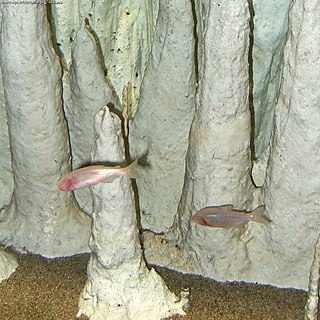
Amphipoda is an order of malacostracan crustaceans with no carapace and generally with laterally compressed bodies. Amphipods range in size from 1 to 340 millimetres and are mostly detritivores or scavengers. There are more than 9,900 amphipod species so far described. They are mostly marine animals, but are found in almost all aquatic environments. Some 1,900 species live in fresh water, and the order also includes the terrestrial sandhoppers such as Talitrus saltator and Arcitalitrus sylvaticus.

Gammaridea is one of the suborders of the order Amphipoda, comprising small, shrimp-like crustaceans. Until recently, in a traditional classification, it encompassed about 7,275 (92%) of the 7,900 species of amphipods described by then, in approximately 1,000 genera, divided among around 125 families. That concept of Gammaridea included almost all freshwater amphipods, while most of the members still were marine.

Lysianassidae is a family of marine amphipods, containing the following genera:

Stygofauna are any fauna that live in groundwater systems or aquifers, such as caves, fissures and vugs. Stygofauna and troglofauna are the two types of subterranean fauna. Both are associated with subterranean environments – stygofauna are associated with water, and troglofauna with caves and spaces above the water table. Stygofauna can live within freshwater aquifers and within the pore spaces of limestone, calcrete or laterite, whilst larger animals can be found in cave waters and wells. Stygofaunal animals, like troglofauna, are divided into three groups based on their life history - stygophiles, stygoxenes, and stygobites.
- Stygophiles inhabit both surface and subterranean aquatic environments, but are not necessarily restricted to either.
- Stygoxenes are like stygophiles, except they are defined as accidental or occasional presence in subterranean waters. Stygophiles and stygoxenes may live for part of their lives in caves, but don't complete their life cycle in them.
- Stygobites are obligate, or strictly subterranean, aquatic animals and complete their entire life in this environment.

Gammaridae is a family of amphipods. In North America they are included among the folk taxonomic category of "scuds", and otherwise gammarids is usually used as a common name.

Gammarus roeselii is a species of freshwater amphipod native to Europe.

Gammarus is an amphipod crustacean genus in the family Gammaridae. It contains more than 200 described species, making it one of the most species-rich genera of crustaceans. Different species have different optimal conditions, particularly in terms of salinity, and different tolerances; Gammarus pulex, for instance, is a purely freshwater species, while Gammarus locusta is estuarine, only living where the salinity is greater than 25‰.

Niphargus is by far the largest genus of its family, the Niphargidae, and the largest of all freshwater amphipod genera.
Niphargus hrabei is a species of crustacean in family Niphargidae. It is an originally Ponto-Caspian species that was found in the River Danube in Bavaria in the mid 1990s. It is now known to occur in Austria, Croatia, Hungary, Romania, Russia, Serbia and Montenegro, Slovakia, and Ukraine. It is listed as a vulnerable species on the IUCN Red List.

Niphargidae is a family of amphipod crustaceans. Its distribution is in western Eurasia, and its members mainly live in subterranean freshwaters habitats. It contains the following genera:
Niphargus tatrensis is a troglobitic species of crustacean in the family Niphargidae, living in the karst waters of Austria, the Czech Republic, Hungary, Poland, and Slovakia. It can be found in caves, and also in karst springs and in wells in the karstic areas.

Cecilioides acicula, common name the "blind snail" or "blind awlsnail", is a species of very small, air-breathing land snail, a terrestrial pulmonate gastropod mollusk in the family Ferussaciidae.

Amphilochidae is a family of amphipod crustaceans, containing the following genera:
Martensia martensi is a species of amphipod crustacean, and the only species in the genus Martensia. It occurs in waters around Svalbard at depths of 37–95 metres (121–312 ft).

Bogidiellidae is a family of amphipod crustaceans, containing the following genera:
Stygobromus russelli, known generally as the Russell stygobromid or Russell's cave amphipod, is a species of amphipod in the family Crangonyctidae. It is endemic to Texas in the United States.
Anthony John Whitten was a British conservationist, zoologist, and herpetologist. He was a senior adviser at Fauna and Flora International, where he was regional director for Asia Pacific, and was a former biodiversity specialist with the World Bank. He co-authored several books on the ecology of Southeast Asia and published over 100 field guides in local languages. Born in Dulwich, London, Whitten attended Dulwich College and the University of Southampton. In graduate school he spent two years studying gibbons on the Indonesian island of Siberut, earning his PhD from Cambridge in 1980. He and his wife, zoologist Jane E. J. Whitten, later lived in Indonesia for 10 years. He established a working group on karst ecosystems for the International Union for Conservation of Nature (IUCN), and in 2016 was part of a research team that discovered 15 new species of geckos in Myanmar. He died in 2017, aged 64, as the result of a car collision while bicycling. He is commemorated in the scientific names of at least 13 species, including the geckos Hemiphyllodactylus tonywhitteni and Cnemaspis whittenorum.
Niphargellus glenniei, also known as the south-western groundwater shrimp, is a species of amphipod from within the family Niphargidae. A native of the United Kingdom, it has been placed in the UK Biodiversity Action Plan list of priority species. It is the first aquatic troglobite to be given a conservation status within the UK.
Niphargellus is a genus of Amphipod crustaceans within the family Niphargidae. The genus contains three known species, which are characterized by the absence of D-setae on the Amphipods mandibular palp. The presence or absence of setae, specifically the D-setae, is a distinguishing feature used to classify organisms within the genus.







